Multifaceted talent. German minesweepers type "1935"
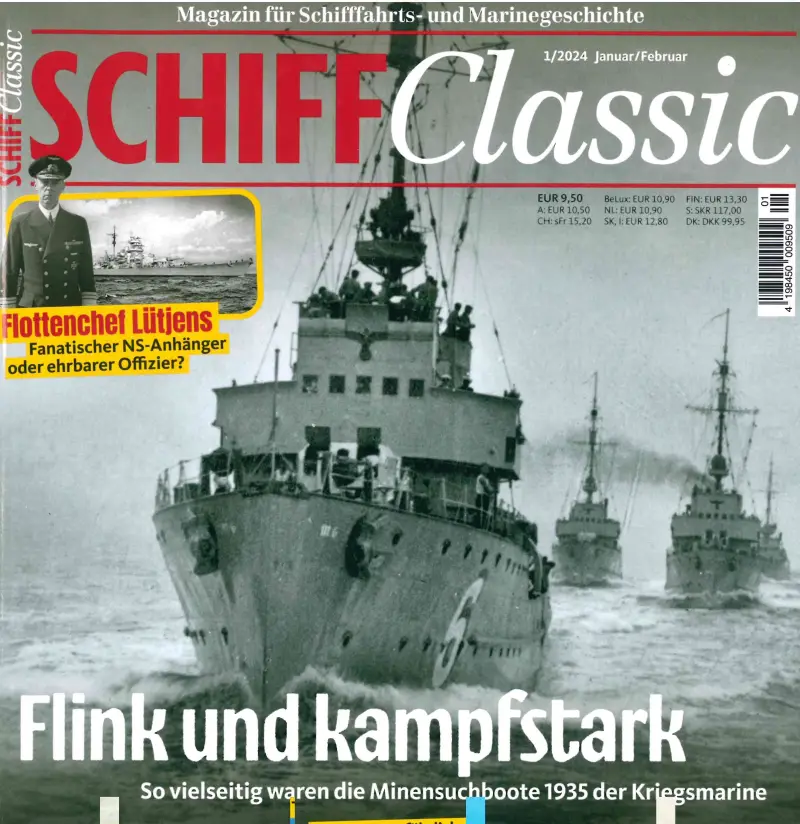
Translation of the article Seetuechtig, kampfstark, vielseitig. Deutsche Minensuchboote 1935, published in the German magazine Schiff Classic No. 1/2024.
Author: Hans Karr (reserve frigate captain).
Translation: Slug_BDMP.
Translator's note. Thank you for your help in translating some technical details Alexandra, aka navy_korabel. I also thank EFZ for checking the spelling and editing all my translations for VO.
From the first to the last day of World War II, the latest minesweepers of the 1935 type were an important element of the German fleet. They were used not only to detect and destroy mines, lay them and fight submarines, but also, thanks to powerful artillery weapons, to combat enemy light surface forces.
January 1778, War of Independence of the North American Colonies (1778–1783). Pontoons with barrels filled with gunpowder floating on the Delaware River cause panic on British ships anchored in Philadelphia. The actual damage was minimal, but the first step towards creating a sea mine weapons was made (this incident was included in history like Barrel Battle. – Approx. translator).
Reliably working examples of sea mines appeared by the 1870s. Since that time, constantly improving, they have firmly taken their place in the arsenals of sea powers. The first case of large-scale use of a new type of weapon was the Russo-Japanese War of 1904–1905. Then the question arose about protection from it.
The creation of special ships to combat sea mines has not been a priority in the development of fleets for a long time. The fleet of the German Empire used obsolete destroyers for this purpose. In case of war, it was supposed to additionally use civilian vessels - tugs, fishing boats, etc. But the experience of the first months of the war showed that everything is not so simple. Specialized ships were needed, and in 1915–1916 they appeared.
New class of ships
After defeat in the war, in accordance with the terms of the Treaty of Versailles, Germany was obliged to clear mines from the areas assigned to it in the North Sea. To do this, it was necessary to maintain a large number of minesweepers in working condition, which, after completion of these works, mostly remained in the Reichsmarine. But by the 1930s they were so worn out that the question of replacement arose.
According to the decree of 1935, based on the successful project 1916, a new minesweeper of the 1935 type was proposed. During the development, new trends in the development of mine action weapons had to be taken into account.
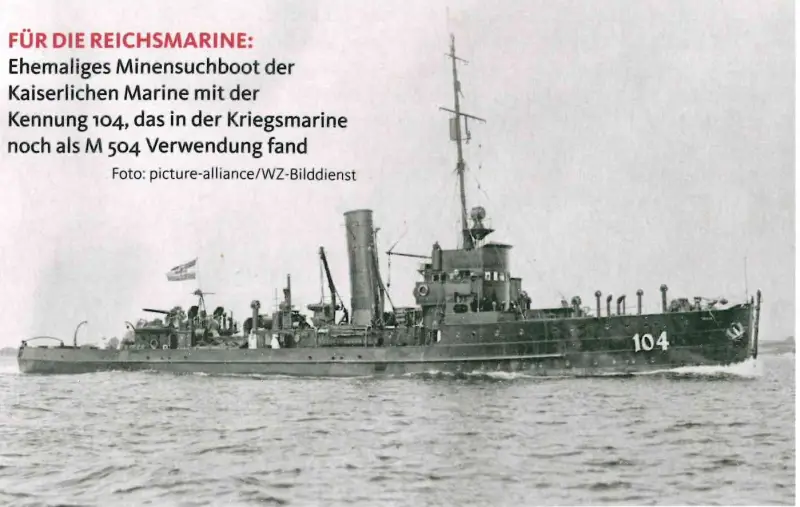
Minesweeper type "1916" of the German Imperial Navy with tail number "104", which served in the Kriegsmarine under the designation "M504"
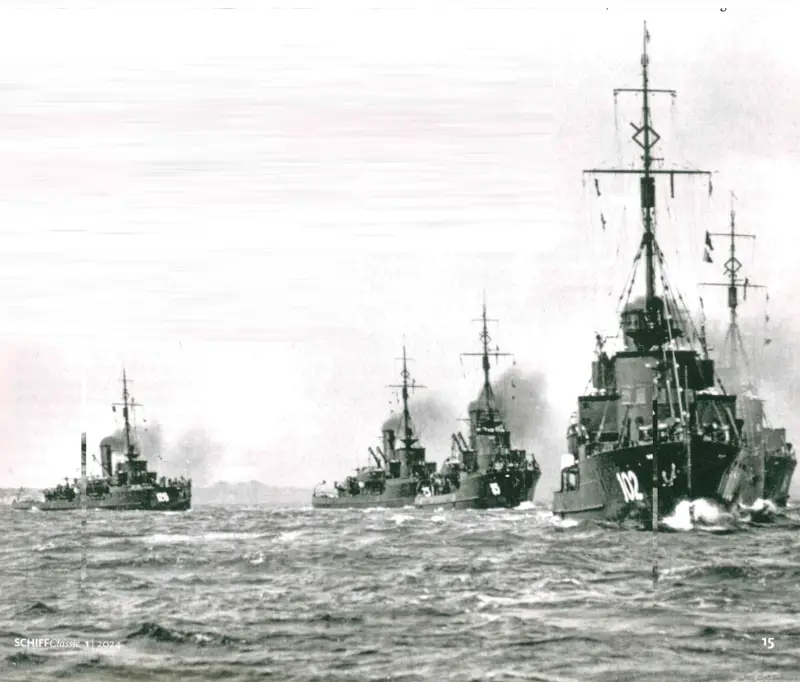
Minesweepers of the 1916 type of the Imperial Navy. These ships were among the first specifically designed for mine defense. Actively used since 1917.
In addition, these ships had to be capable of performing patrol and anti-submarine missions. The implementation of these requirements led to an increase in displacement: equipment for detecting and neutralizing mines and other weapons and equipment required space.
According to the terms of the London Naval Treaty of 1930, ships with a displacement of up to 600 tons were not subject to any quantitative or qualitative restrictions. Therefore, the German side declared a displacement of 600 tons for this class of ships, although this was not true. From the very beginning of development, it became clear that in order to implement all the military’s requirements, this limit would have to be exceeded.
To cover all the technical, logistical and administrative needs of the connection of ships - the flotilla - various options for minesweepers were provided, such as: the flagship ship of the flotilla, the ship of the flagship engineer, the ship of the flagship miner, the ship for accommodating a doctor and medical staff...
There were eight such options in total (from Type A to Type H).
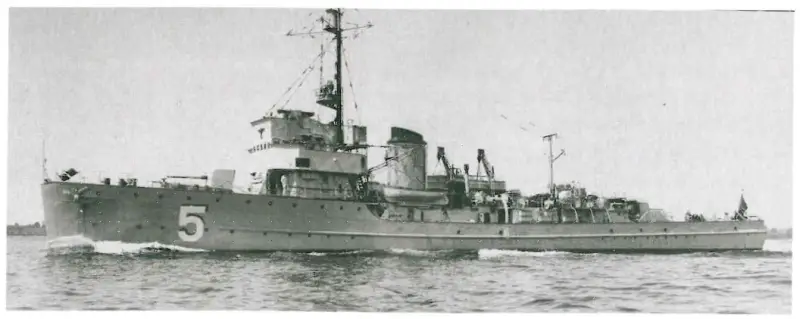
M5 - one of the first minesweepers of a new type - “1935”
First series of ships
The first order for the construction of nine minesweepers was issued at the end of 1935 to three shipyards: the Hamburg Stülken Werft (3 units), the Stettin Oderwerke (3 units) and the Flenderwerke in Lübeck (also 3 units).
The lead ship - M1 - left the slipway in Hamburg on May 5, 1937 and entered service on September 1, 1938. The last ship of pre-war construction - M20 - was launched on June 16, 1939. The flag over it was raised on December 11, 1939.
After the outbreak of war and the resulting increased needs of the fleet, the Kriegsmarine command planned the construction of 260 minesweepers. In fact, from September 1938 to June 1943, 69 units of this type, built at ten shipyards, entered service.
The main reasons that the plans were not fully implemented were:
– the complexity of the design and the associated construction time (430 man-hours per ship);
– high requirements for the qualifications of the machine team;
– shortage of materials, oil and labor caused by the war.
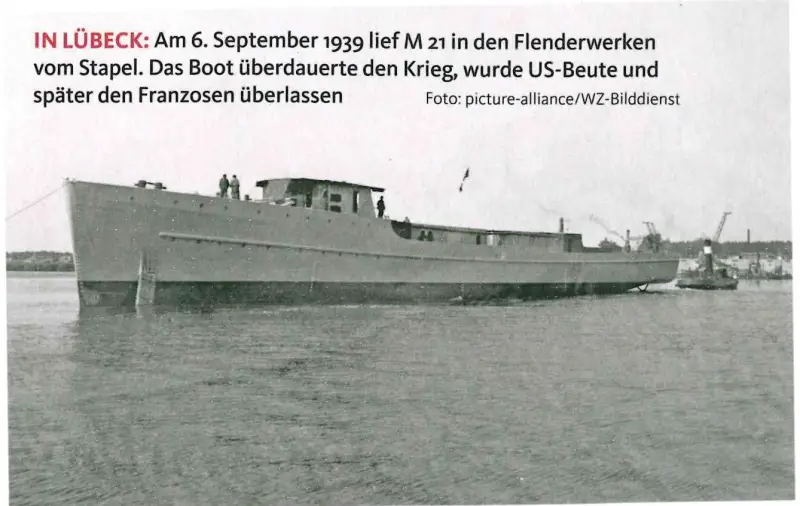
The hull of the M21 launched from the stocks in Lübeck. This ship survived the war and was given as a trophy to the Americans, who handed it over to France.
Type M40 and M43
The above problems forced the creation of simplified ships of the M40 type, which could be built in large quantities at small shipyards, and coal, abundantly available in Germany, was used as fuel for their vehicles. From September 1942 to December 1944, 129 of the 240 planned minesweepers of this type entered service.
Their further development was the project of minesweepers of the M43 type.
It provided for a sectional construction principle. Individual sections were manufactured at various factories in the interior of the country, and then transported by rail to the Neptune shipyard in Rostock or Schichau in Königsberg, where final assembly was carried out. This was supposed to ensure an even higher pace of construction.
The lead M601 entered service on November 22, 1944. In total, of the planned 450 ships of the “1943” type, 17 were built.
Устройство
With a hull length of 68,1 meters, a beam of 8,7 meters and a draft of 2,65 meters, the standard displacement was 772 tons. The welded body with a longitudinal-transverse layout was divided into 12 waterproof compartments. The bottom was double along 87 percent of the hull length. In order to save weight, the superstructure was made of aluminum alloy, and only the bridge was protected by 10 mm steel armor. The first ships of the series (from M1 to M24) had sharp-cheeked contours of the bow of the hull. Starting with the M25, the sharp cheekbone was abandoned.
The main power plant included two high-pressure oil-heated boilers (pressure - 32 atmospheres, steam temperature - 450 degrees), generating steam for two double-expansion steam engines with a capacity of 1 horsepower. These machines drove two propeller shafts with constant pitch propellers. This provided the ships with a maximum speed of 750 knots.
The first two ships - M1 and M2 - were equipped as an experiment with Voith-Schneider wing propulsors, which worked well. All ships, starting with the M25, were supposed to receive such propulsors, but their protracted production and the shortage of materials and components caused by the outbreak of the war did not allow these plans to come true.
A coal reserve of 143 tons provided the Thirty-Fifth with a cruising range of 5 nautical miles at a speed of 000 knots.
A large amount of electricity was required to ensure the operation of on-board equipment, anti-mine weapons and the magnetic mine protection system. It was produced by a turbogenerator and four diesel generators (2x20 kW and 2x40 kW). All this complex equipment required highly qualified personnel, which could only be achieved through careful, long-term training.
The main caliber of the ships included two 105-mm 10.5 cm/45 SK C/32 cannons with shields, mounted at the bow and stern. Anti-aircraft armament consisted of one 37-mm semi-automatic cannon 3.7 cm/L83 SK C/30 and two 20-mm machine guns 2 cm/65 C/30.
During the war, the number of 20-mm anti-aircraft guns, including 4-barrel versions, increased.
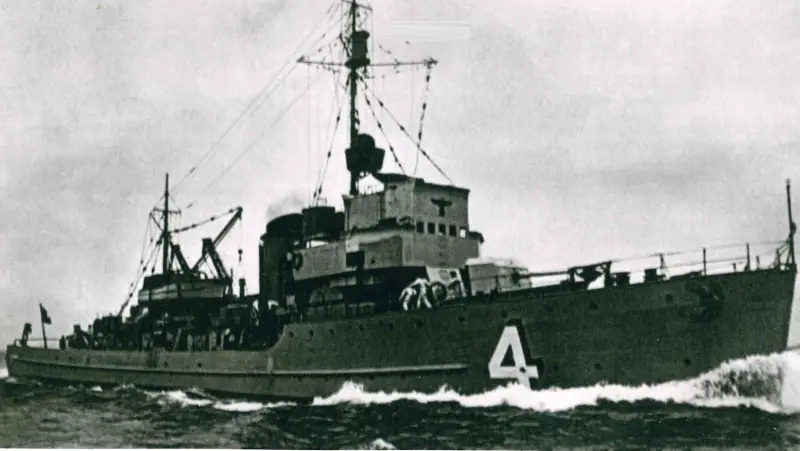
Minesweeper M4 of the 1st minesweeper flotilla. Built at the Oderwerk in Stettin. Since 1945, he cleared the Baltic Sea of mines as part of the German mine-sweeping administration
Mine weapons were as follows:
– against contact mines:
• cutting trawl;
• guardian paravan;
– against bottom mines with a magnetic fuse:
• electrode electromagnetic trawl;
• loop electromagnetic trawl;
• solenoid electromagnetic trawl;
– against bottom mines with an acoustic fuse:
• acoustic buoys;
• explosive sound source (VIS).
The Thirty-Fifths could lay mines themselves. For this purpose, on the deck, along the sides, there were 39-meter mine rails. The ships could carry from 20 to 60 mines of various types on board. But in this case, the use of a stern gun and towed mine action equipment was either impossible or limited.
To search for submarines, there was on board the most modern sonar of that time, and to destroy the submarines, four bomb throwers were installed on board.
There was a rangefinder on the roof of the bridge. Since 1944, some ships in the series have received radars.
Additional watercraft included a tug, two dinghies and a motor launch. On the first ships of the series, for raising/lowering the boat in the middle part of the hull on the starboard side there was a pair of gravity davits designed by the Patent company. Starting with the M13, they were replaced by a lift in the form of a ten-meter frame, which became the “calling card” of this type of ship and was nicknamed “football goals” by sailors.
The crew size was initially 84 people. During the war, it increased to 119 - these were mainly numbers of anti-aircraft gun crews.
The urgent need for warships forced the reclassification of some of the "thirty-fifths" into warships (Kampfboot). They lost the second mast and the “football goal”, and anti-aircraft guns were installed in the vacant space.
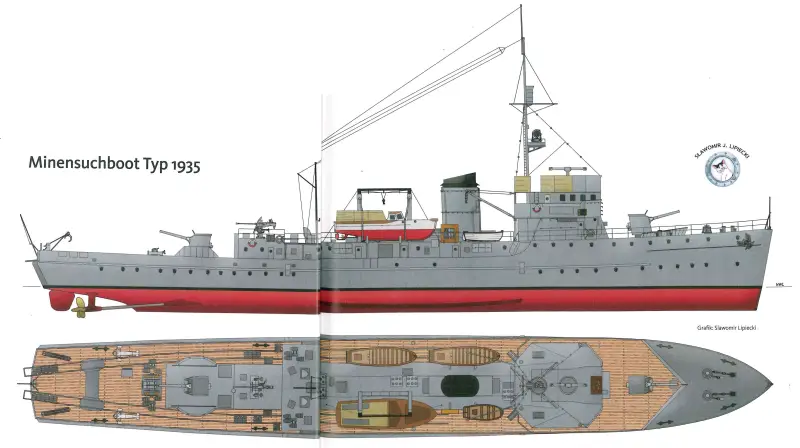
General diagram of minesweepers of the "1935" type
"Workhorses"
Minesweepers of the 1935 type fought from the first to the last day of the war. In the Baltic and the North Sea, in Norway and the English Channel - everywhere there was plenty of varied work for them. And this was not only the clearance of mines, their installation and the fight against submarines. Powerful artillery weapons allowed them to effectively fight enemy light surface forces. It’s not for nothing that English sailors nicknamed them “Channel Destroyers.”
It can be said without exaggeration that minesweepers of the 1935 type were ideal ships for performing combat and security missions in the coastal zone.
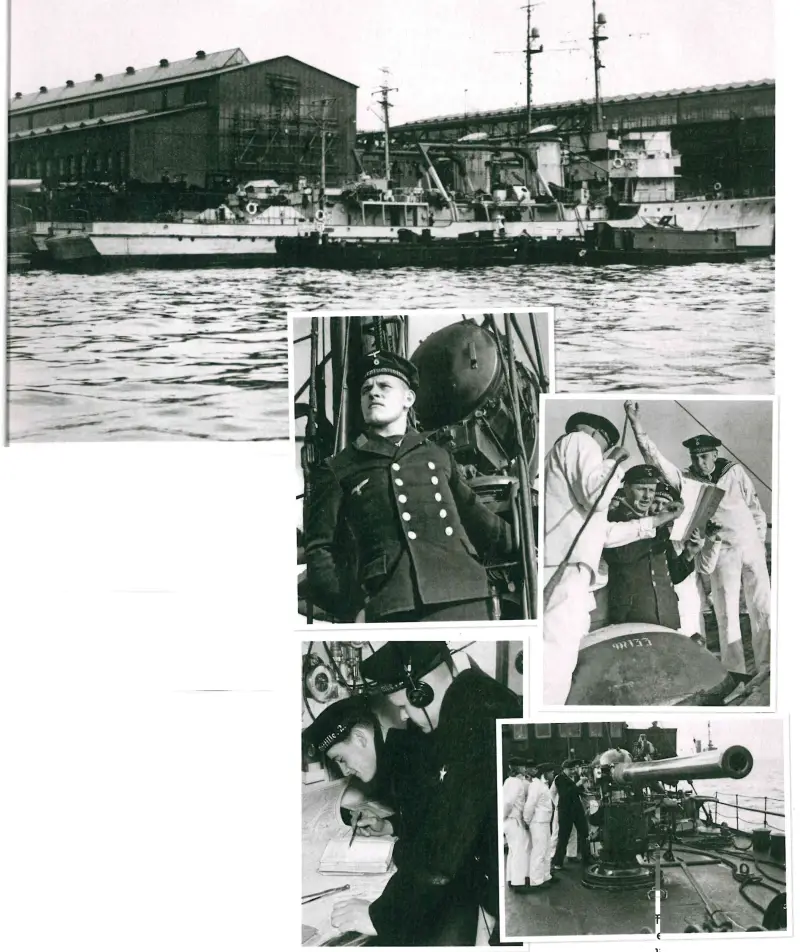
Above is one of the minesweepers “1935” in the process of completion. The weapons have not yet been installed. Presumably Atlas-Werke, Bremen.
Below - daily life on board.
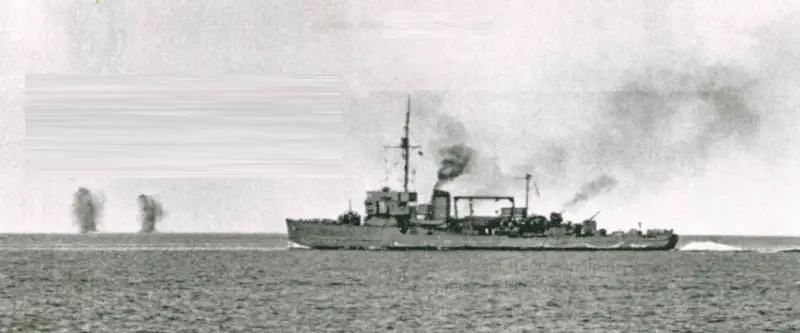
During the exercises. The photo clearly shows the lift of the motor boat - the “football goal”. In the background are detonating mines
Combat way
Already in the Polish campaign of 1939, minesweepers of the 1935 type took part in combat operations in the western part of the Bay of Danzig: mine action missions, shelling of coastal targets, fire support for Wehrmacht units advancing on the Hel Spit, as well as escorting large ships of the fleet. Polish submarines were repeatedly discovered, depth charges were dropped, but there was no reliable destruction of the submarines.
During the remaining months of 1939 and early 1940, the main theater of operations became the German Bight and the North Sea. Daily tasks at this time were: installation of minefields of the Western Wall, control of the passages left for their own use, the fight against British submarines, and convoy service. To this we can add training and putting together new ship formations. In January 1940, the first victories came: the destruction of two British submarines - Starfish and Seahorse.
The 2nd minesweeper flotilla took part in Operation Exercise on the Weser - the capture of Denmark and Norway. She landed troops at Egersund on the southwest coast of Norway. This was followed by the escort of convoys from Germany and in the opposite direction. The 1st Flotilla also took part in this.
Mines and British submarines were a constant danger and made it difficult to relax. Then the first losses came. On June 18, the M5 hit a mine in Ramsøyfjord and sank.
In the Norwegian campaign, the M1 especially distinguished itself under the command of Lieutenant Commander Hans Bartels. This ship went down in the history of naval warfare as the “Tiger of the Fjords.” He was responsible for the daring operation to capture Egersund, where a Norwegian destroyer, four destroyers, and four armed whaling ships were taken as trophies; interception of numerous merchant and fishing vessels attempting to escape to England; daring operations on the Norwegian coast...
For these successes and the skill, courage and a fair amount of adventurism demonstrated, Bartels was awarded the Knight's Cross, becoming the tenth sailor in general and the first of the minesweeper sailors to receive this award. The entire crew was awarded Iron Crosses 2nd class.
The M1 operated in Norway throughout the war and was sunk by the enemy on January 12, 1945. aviation. Bartels, by then already a corvetten captain, was tasked in November 1943 with forming and training the first special forces unit of the Kriegsmarine - Einheit von Marine-Kleinkampfmitteln.
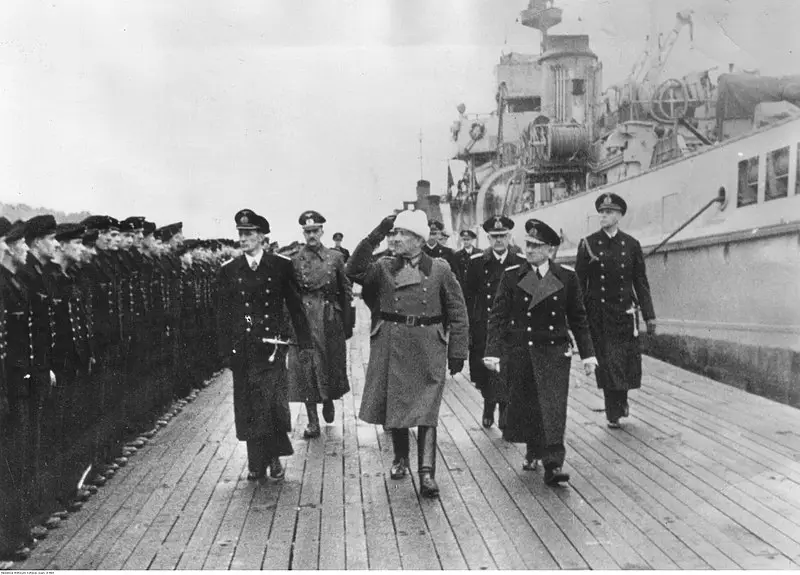
Distinguished guests on board the M1. On the left is Lieutenant Commander Bartels, in the center is Colonel General Nicholas von Falkenhorst (commander of the German forces in Norway), on the right is Admiral Otto von Schrader (commander of the naval forces in western Norway)
Throughout the war, the Thirty-Fifths operated along the entire Norwegian coast.
After the capture of France, ports on the Atlantic coast came under German control. This significantly improved the strategic position of the German fleet and made it possible to constantly influence British sea communications, including with the help of mines. The British had to make great efforts to ensure the safety of these routes for their transport and warships. This task was further complicated by the fact that most of the mine-resistant ships were hastily converted from civilian tugs, trawlers and similar vessels. At the same time, they were scattered across numerous small harbors.
The 1st and 2nd minesweeper flotillas soon found themselves in the English Channel and the Bay of Biscay. There were not enough new ships. The construction of minesweepers of the 1935 type was delayed, so the load on the existing ones was very high. Mine sweeping, guard and convoy service, in general, all the menial, everyday activities of the fleet. You could never be sure that the passages cleared of mines would not be mined again in a couple of days. In addition to this, there is a constant threat from enemy aircraft and light surface forces.
The preparation of large-scale operations, such as the unrealized landing in Britain (“Seelow”), required special stress from all the very few forces of the Kriegsmarine.
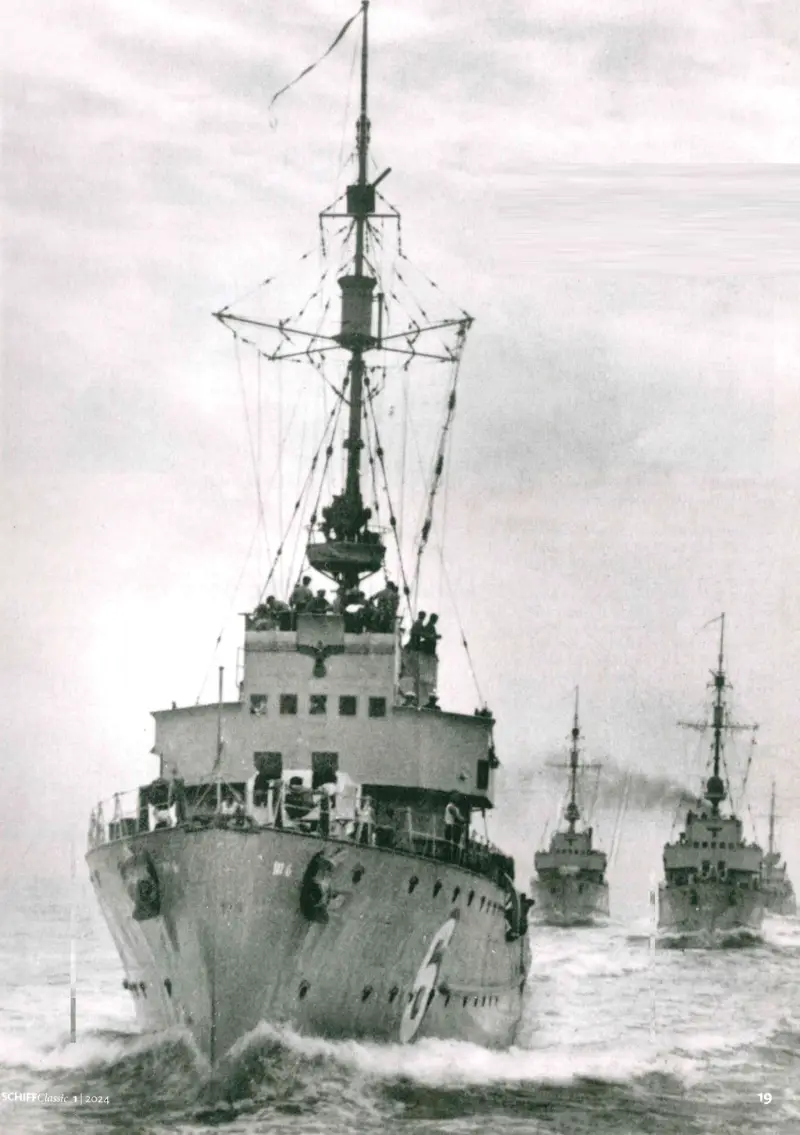
On a military campaign
The main task has always been clearing mines and maintaining sea communications in a safe condition. It was also important that the enemy, who discovered the mine-sweeping work, would not be able to draw conclusions about the nature of the future operation. An example is the provision of the 2nd flotilla for a combat cruise and the return of the auxiliary cruiser Michel from it.
As the motto of the German mine-sweeping force says: “Where the fleet has yet to go, we have already gone” (Wo die Flotte faert, sind wir schon gewesen).
By the turn of 1942–1943, 23 minesweepers of the 1935 type were in service. Material and human losses were an everyday occurrence. Thus, on May 14, 1943, in front of Hoek van Holland, the M18 was sunk by British torpedo boats. In July 1943, an M153 was killed in a battle with a British destroyer and torpedo boats... In total, fourteen “1935” were killed in the English Channel and the Bay of Biscay.
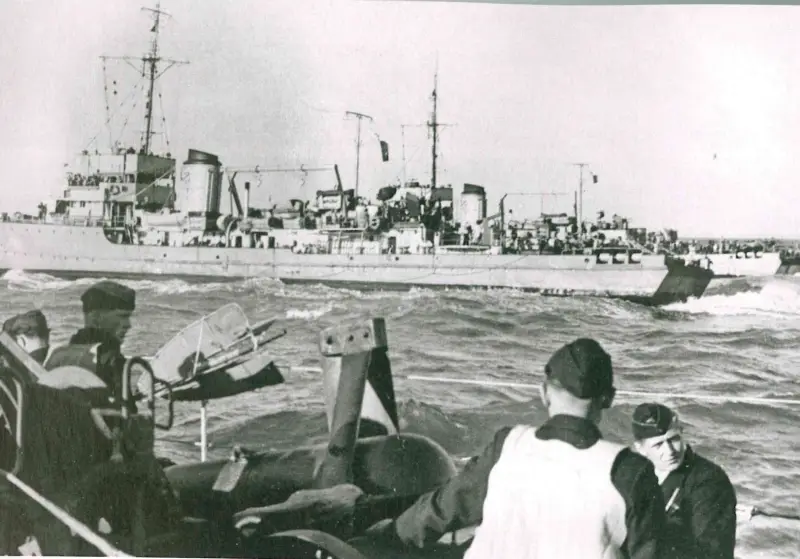
As part of the connection
Towards the end
After the Allied landings in France, 14 minesweepers of the 2nd and 6th flotillas were in harbors on the English Channel coast, most with varying degrees of damage. All of them were rendered unusable, and the crews left on the ground towards Germany. Numerous ships continued to fight in Saint-Nazaire and Lorient, declared “fortresses,” as well as on the islands until the end of the war, including three “thirty-fifths” (M10, M38, M85). M10 was sunk by field artillery on 13 March 1945.
Let's return to the Baltic.
Here, from the very beginning of the war against the USSR (from June 22, 1941), numerous mine-sweeping forces were deployed. Minesweepers of the 1935 type of the 1st and 3rd flotillas were engaged in clearing mines from ports in the Baltic and in convoy service. Ultimately, it was possible to lock the Soviet fleet in the Gulf of Finland with the help of mines and net barriers. The ships guarding them were constantly exposed to the danger of Soviet attacks. And here the powerful 105-mm guns of the “thirty-fifths” made them the main force of the security formations.
As the land front advanced westward and Finland left the war in September 1944, the fighting in the Gulf of Finland ended.
In the eastern Baltic, minesweepers were engaged in escorting convoys, transporting troops and cargo, and evacuating refugees and the wounded. And all this under constant attacks from Soviet aviation and light naval forces.
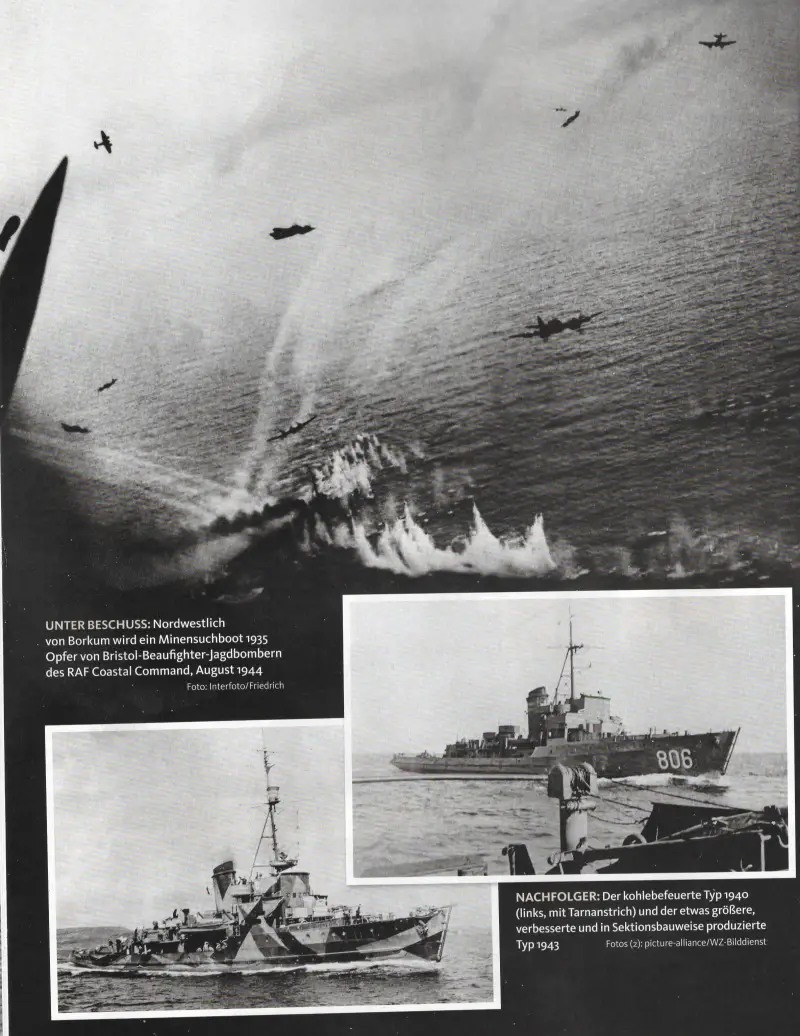
Above - British Bristol Beaufighter fighter-bombers attack the minesweeper 1935 near the island of Borkum. August 1944
Bottom left is the minesweeper “1940” with coal-fired boilers.
In the center is the minesweeper "1943", increased in size compared to the "1940" and adapted for construction in a sectional manner
At the service of the winners
During the war, 29 minesweepers of the 1935 type were killed by the enemy. Another five were destroyed by their own crews to avoid being captured by the enemy. The remaining 35 units went to the winners as trophies.
The USSR received 13 of them. The ships were transferred to the Black Sea Fleet, where they served as special-purpose vessels. Some remained in service until the 1960s.
American and British trophies were transferred to the German Mine Administration (GM/SA), and until September 1947, German crews under British control were clearing mines from the Baltic and North Seas.
The resurgent French Navy was forced to do the same off its coast. Therefore, the natural decision was to use German minesweepers stationed in French ports for this purpose, including 5 “thirty-fifths” - M9, M24, M28, M38, M85.
Since it was impossible to operate and repair ships without German specialists, they were recruited from among prisoners of war. Despite mutual distrust, there were willing people. The ships went to sea with mixed crews. From the end of 1946, the gradual liberation of the Germans began, and their positions were occupied by the French.
After the completion of mine sweeping work in September 1947, these ships, as well as the ships of the GM/SA, which had been disbanded by that time, were included in the French fleet. They were named after French rivers and served until the late 1950s.
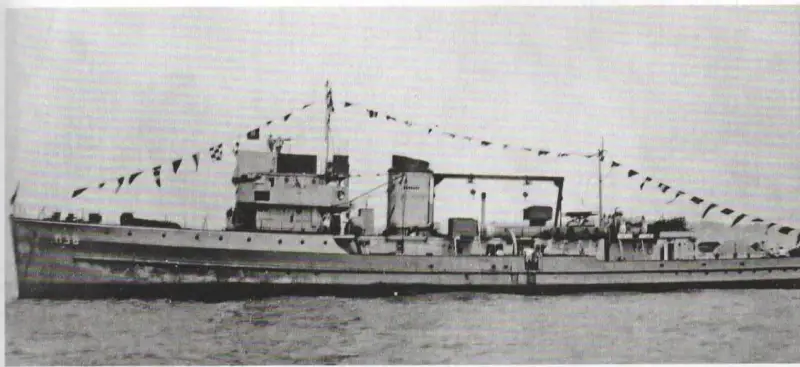
French trophy M38. In 1947 it was included in the French fleet under the name Oise. In 1958 renamed Q90 and removed from service.
Once again under the German flag
At the turn of 1956–1957, the newly created German Navy - the Bundesmarine - purchased 5 minesweepers "1935" from France for 1 million marks per unit. In the defense budget, this item of expenditure was called "payment for maintenance." The ships received the following names:
– Biene (“Bee”) – ex. Belfort, former M205;
– Bremse (“Gadfly”) – former. Vimy, former M253;
– Brummer (“Carrion Fly”) – former. Yser, former M85;
– Hummel (“Bumblebee”) – former. Laffaux, ex. M81;
– Wespe (“Wasp”) – former. Ailette, ex. M24.
With hull numbers F 207–F 211, they formed the 1st squadron of escort ships.
Repairs and refitting of this "insect flotilla" or more formally "Wespe class ships" were completed in 1958. Changes affected weapons. Now it included one 105 mm gun, one 40 mm and several 20 mm anti-aircraft guns. All anti-mine weapons were removed. |A Hodgehog bomb launcher was installed on the bow.
In 1960, the ships were reclassified as training ships. The 105 mm gun was replaced with a 40 mm one. Additional living quarters have been equipped. The training "OS" service continued until October 1963.
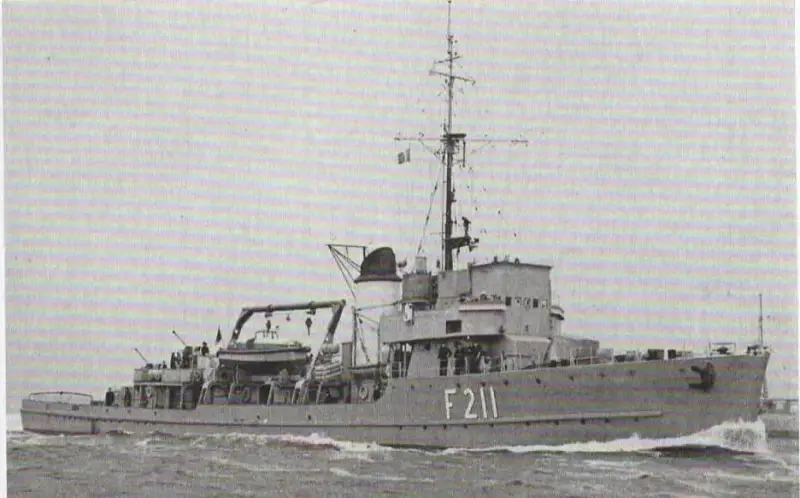
Patrol and then training ship Wespe (formerly M24). The boat lift - “football goal” - remained his calling card until his last days
End station
At the turn of the 1950s and 1960s, the Thirty-Fifths were the largest warships of the nascent Bundesmarine. They made numerous overseas voyages, visiting the ports of their closest neighbors, as well as the Mediterranean region and North Africa. In many of them, they became the first guests from among German warships after World War II.
At the end of active service, they were used as blockers or target ships. Wespe was sunk as a target in October 1973, while the rest went on pins and needles in the mid-seventies.
Thus ended the almost 40-year service of this very successful class of ships. Distinguished by their high seaworthiness, versatility, reliability and survivability, they were the real “workhorses” of the fleet in war and in peacetime.
Translator's note. You can find out about the combat path of most of the 1935 ships here.
Information